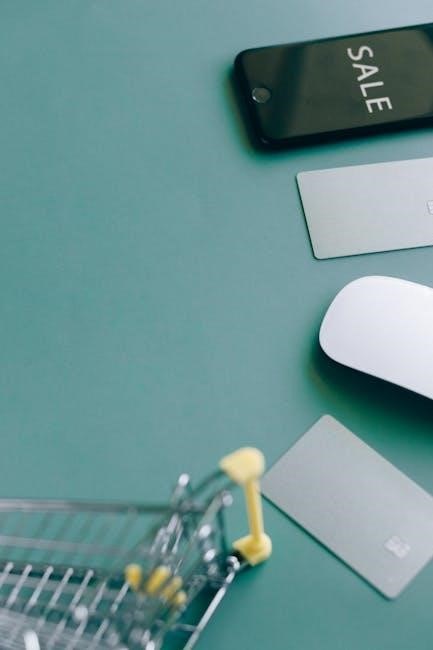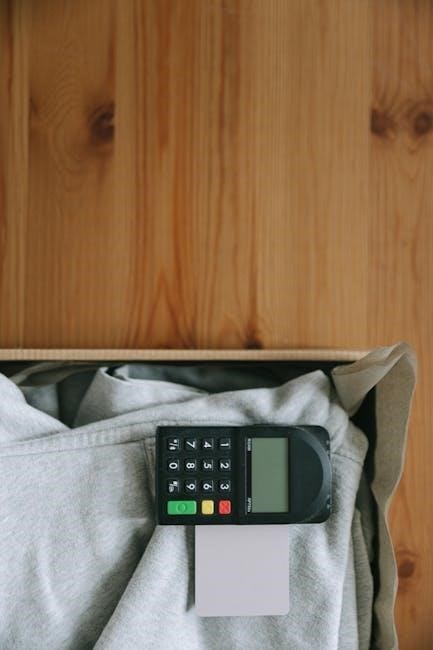The FD150 Credit Card Terminal is a versatile and secure payment solution designed for businesses to process transactions efficiently․ It supports EMV chip and NFC payments, ensuring compliance with modern security standards․ This terminal is user-friendly, offering multiple payment options and seamless integration for various business needs․ Its compact design and advanced features make it an ideal choice for merchants seeking reliable payment processing․

Features and Benefits of the FD150 Terminal
The FD150 Terminal offers a versatile and secure payment processing solution․ It supports EMV chip, NFC payments, and multiple payment methods, ensuring efficient transactions․ Its user-friendly interface and compact design make it ideal for businesses seeking cost-effective payment solutions․
2․1․ EMV Chip and NFC Support
The FD150 Terminal supports EMV chip and NFC payments, ensuring secure and contactless transactions․ EMV chip technology provides enhanced security by encrypting card data, reducing fraud risks․ NFC functionality allows customers to tap their cards or mobile devices for quick payments․ This terminal is compatible with modern payment methods, making it suitable for businesses that prioritize security and convenience․ The combination of EMV and NFC support ensures the terminal meets global payment standards, offering a seamless and efficient payment experience for both merchants and customers․
2․2․ Multiple Payment Options
The FD150 Terminal offers multiple payment options to cater to diverse customer preferences․ It supports swipe, dip, and tap transactions, allowing customers to pay using their preferred method․ Additionally, the terminal accepts manual card entry for situations where card reading is unsuccessful․ It also processes contactless payments, enabling quick and convenient transactions․ The terminal supports various card types, including credit, debit, and EBT cards, making it a versatile solution for businesses․ With these flexible payment options, the FD150 ensures that merchants can accommodate a wide range of payment preferences, enhancing customer satisfaction and streamline transaction processes․
Installation and Setup Guide
Welcome to the FD150 Credit Card Terminal Installation and Setup Guide․ This section provides step-by-step instructions to unpack, connect, and configure your terminal for seamless operation․ Follow the manual carefully to ensure proper setup and functionality․
3․1․ Hardware Setup and Requirements
To set up the FD150 Credit Card Terminal, ensure you have all components from the box, including the terminal, power cord, thermal paper roll, and optional PIN pad․ Locate the card reader slot at the front for inserting cards․ Connect the power cord to the terminal and a nearby outlet․ Install the thermal paper roll by opening the printer cover and aligning the roll correctly․ If using the RP10 PIN pad, connect it to the terminal․ Ensure the terminal is placed on a stable surface with proper ventilation․ Follow the manual for network configuration to enable seamless transaction processing and connectivity․
3․2․ Software Installation Steps
Connect the FD150 terminal to your system and insert the provided installation CD or download the software from the official website․ Run the installer and follow on-screen prompts to install the necessary drivers and payment processing software․ Once installed, configure network settings to ensure proper connectivity․ Restart the terminal and system to apply changes․ Test the setup by performing a test transaction to confirm functionality․ Refer to the FD150 manual for detailed guidance and troubleshooting tips during installation․ Ensure all software updates are installed for optimal performance and security․
Processing Transactions with the FD150
The FD150 enables seamless transaction processing through swipe, dip, or tap methods․ It supports EMV chip and NFC payments, ensuring secure and efficient transactions․ The terminal guides users through each step, making it easy to process payments and print receipts․
4․1․ Basic Transaction Operations
Processing transactions with the FD150 is straightforward․ Begin by having the customer insert, swipe, or tap their card․ The terminal will prompt for payment method selection․ Once selected, enter the transaction amount and any additional details if required․ The system will communicate with the payment network to authorize the transaction․ Upon approval, the terminal will print a receipt for both the merchant and the customer․ For contactless payments, simply tap the card near the reader․ The FD150 ensures a smooth and efficient checkout experience, supporting multiple payment methods and providing clear on-screen instructions throughout the process․
4․2․ Payment Methods: Swipe, Dip, Tap
The FD150 supports three primary payment methods: swipe, dip, and tap․ For magnetic stripe cards, simply swipe the card through the terminal’s reader․ For EMV chip cards, insert the card into the slot at the front of the terminal until the chip is no longer visible․ Contactless payments, such as NFC-enabled cards or mobile wallets, can be made by tapping the card or device near the terminal’s contactless reader․ The FD150 prompts the user to select the payment method and confirms the transaction with on-screen instructions․ These methods ensure fast, secure, and convenient transactions, catering to various customer preferences and card types․
4․3․ Manual Card Entry Process
To perform a manual card entry on the FD150, navigate to the manual entry option typically found under the “Other” or “More” menu․ Enter the card number using the keypad, ensuring accuracy to prevent errors․ Next, input the expiration date and security code if prompted․ Review the details for correctness, then press “Enter” or “OK” to proceed․ The terminal will process the transaction․ It’s advisable to obtain customer authorization, such as a signature, for security․ Ensure all steps are followed carefully to avoid declined payments․ Having the manual nearby can help clarify any uncertainties during the process․
4․4․ Contactless Payment Processing
The FD150 supports contactless payment processing, allowing customers to pay by tapping their card or mobile device near the terminal․ To initiate a contactless transaction, ensure the terminal is in “Ready” mode․ Instruct the customer to hold their contactless card or device within 1-2 inches of the reader․ The terminal will detect the card and display a confirmation message․ If prompted, the customer may need to enter a PIN or sign․ Once approved, a receipt will be printed․ Contactless payments are fast, secure, and convenient, leveraging NFC technology for seamless transactions․ This feature is ideal for quick checkouts and enhances customer satisfaction․

Troubleshooting Common Issues
The FD150 terminal may encounter issues like error codes or connectivity problems․ Always check the power supply and ensure proper card insertion․ Refer to the manual for specific error code solutions and restart the terminal if necessary․ Regularly update software to avoid operational glitches․ For unresolved issues, contact technical support for assistance․
5․1․ Common Terminal Issues and Solutions
Common issues with the FD150 terminal include card insertion problems, error codes, and connectivity issues․ Ensure the card is inserted correctly with the chip facing down․ If an error code appears, refer to the manual for specific solutions․ Connectivity problems can often be resolved by restarting the terminal or checking the internet connection․ For persistent issues, update the terminal software to the latest version․ If the terminal fails to power on, verify the power cord is securely connected․ For unresolved issues, contact customer support for further assistance․ Regular maintenance and updates can prevent many common problems․ Always follow the manual’s troubleshooting guide․
5․2․ Understanding Error Codes
Understanding error codes on the FD150 terminal is crucial for resolving issues quickly․ Common error codes like “101” indicate connectivity problems, while “203” signals invalid card data․ Refer to the FD150 manual for a comprehensive list of codes and their meanings․ If an error occurs, restart the terminal or check the internet connection․ For card-related errors, ensure the card is inserted correctly or try manual entry․ If issues persist, contact support for assistance․ Keeping the terminal updated with the latest software can help minimize errors․ Always consult the error code reference guide in the manual for specific solutions․

Additional Functionalities
The FD150 terminal offers features like credit balance inquiries and refund issuance, enhancing transaction flexibility․ These tools streamline operations and improve customer satisfaction, making it a comprehensive payment solution․
6․1․ Credit Balance Inquiry Process
The FD150 terminal allows merchants to perform a credit balance inquiry to check a customer’s available credit․ This feature is accessed by pressing the (Other) button, followed by (More), and then selecting the balance inquiry option․ Enter the card information and confirm the transaction type․ The terminal will retrieve and display the credit balance․ This process ensures merchants can provide accurate information to customers, enhancing transaction transparency and efficiency․ The balance inquiry feature is a valuable tool for businesses, offering seamless integration with daily operations and improving customer satisfaction․ It is a key component of the terminal’s additional functionalities․
6․2․ Issuing Refunds
To issue a refund using the FD150 terminal, access the refund option by pressing the appropriate buttons․ Select the refund type and enter the transaction amount․ The terminal will prompt for card details, which can be entered manually or via swipe, dip, or tap․ Once processed, the terminal will confirm the refund and print a receipt․ Ensure the customer signs the receipt and retains a copy for their records․ Refunds are processed securely, adhering to payment network rules․ This feature streamlines returns, enhancing customer satisfaction and operational efficiency for businesses․ It is a key functionality of the FD150 terminal․
Reporting and Batch Settlement
The FD150 terminal provides comprehensive reporting tools to track transactions and manage settlements․ View detailed transaction history and process end-of-day batches efficiently․ Print receipts and maintain accurate records for reconciliation․
7․1․ Viewing Transaction History
To view the transaction history on the FD150 terminal, navigate to the reporting section․ This feature allows you to access a detailed list of all processed transactions, including dates, amounts, and payment methods․ Use the intuitive interface to sort transactions by specific criteria, such as date or transaction type, for easier reconciliation․ Additionally, you can print or export transaction records for further analysis or record-keeping․ This functionality ensures transparency and helps businesses maintain accurate financial records․ The terminal’s reporting tools are designed to streamline accounting processes and provide quick access to essential transaction data․
7․2․ End-of-Day Batch Settlement
End-of-Day (EOD) batch settlement on the FD150 terminal finalizes all transactions processed throughout the day․ To initiate the process, access the terminal’s menu, select the Batch Settlement option, and confirm the action․ The terminal will automatically transmit the batch data to the payment processor for clearing and settlement․ Once completed, a summary report is printed, detailing the total number of transactions, gross amounts, and any potential issues․ This step ensures all transactions are securely processed and prepares the terminal for the next business day․ Regular EOD batch settlements are essential for accurate reconciliation and timely fund transfers․

Security and Compliance
The FD150 ensures secure transactions with EMV chip and NFC support, utilizing encryption and secure authentication, adhering to PCI compliance standards for data protection and fraud prevention․
8․1․ Data Protection Measures
The FD150 Credit Card Terminal prioritizes data security with advanced encryption and secure authentication protocols․ It supports EMV chip technology, ensuring card data is protected during transactions․ The terminal uses tokenization to replace sensitive card information with unique tokens, preventing unauthorized access․ All transactions are encrypted during transmission, complying with PCI DSS standards․ Additionally, the terminal regularly updates its security firmware to address vulnerabilities and maintain compliance with industry regulations․ These measures ensure that customer data remains confidential and protected against potential breaches or fraud attempts․
8․2․ Best Practices for Security
To ensure the FD150 Credit Card Terminal operates securely, follow these best practices: Regularly update the terminal’s firmware to maintain the latest security patches․ Use strong passwords and restrict access to authorized personnel only․ Monitor transactions for unusual activity and report any suspicious behavior immediately․ Store the terminal in a secure location to prevent tampering․ Ensure all staff are trained on security protocols and card handling procedures․ Never share sensitive credentials or leave the terminal unattended during operation․ These practices help safeguard customer data and maintain compliance with industry security standards․
The FD150 Credit Card Terminal is a powerful tool designed to streamline payment processing for businesses․ With its advanced features, including EMV chip and NFC support, it provides a secure and efficient way to handle transactions․ By following the guidelines outlined in this manual, users can maximize the terminal’s functionality and ensure seamless operations․ For further details, refer to the FD150 manual PDF or contact support for assistance․ Regular updates and adherence to security best practices will keep your terminal performing optimally, ensuring a smooth and reliable payment experience for both you and your customers․
Additional Resources
Access the FD150 manual PDF for detailed instructions, or download the quick reference guide for easy navigation․ Contact support for further assistance or troubleshooting help․
10․1․ Accessing the FD150 Manual PDF
To access the FD150 manual PDF, visit the official First Data website or click here to download the guide directly․ This comprehensive resource includes detailed instructions for installation, troubleshooting, and advanced features․ Ensure you have the latest version for the most up-to-date information․ The manual is essential for understanding terminal functionality and resolving common issues․ Print or save the PDF for easy reference during setup or operation․ Additional resources, such as the quick reference guide, are also available for download, providing quick access to key functions and procedures․
10․2․ Contacting Support
For assistance with the FD150 Credit Card Terminal, contact First Data’s dedicated support team․ Support is available via phone, email, or live chat on their official website․ Visit the support page for contact details and additional resources․ Representatives are available 24/7 to address technical issues, troubleshooting, or general inquiries․ When reaching out, have your terminal serial number ready for faster assistance․ The support team can also guide you through software updates, error resolution, and optimal terminal configuration․ Their expertise ensures minimal downtime and maximized performance for your payment processing needs․